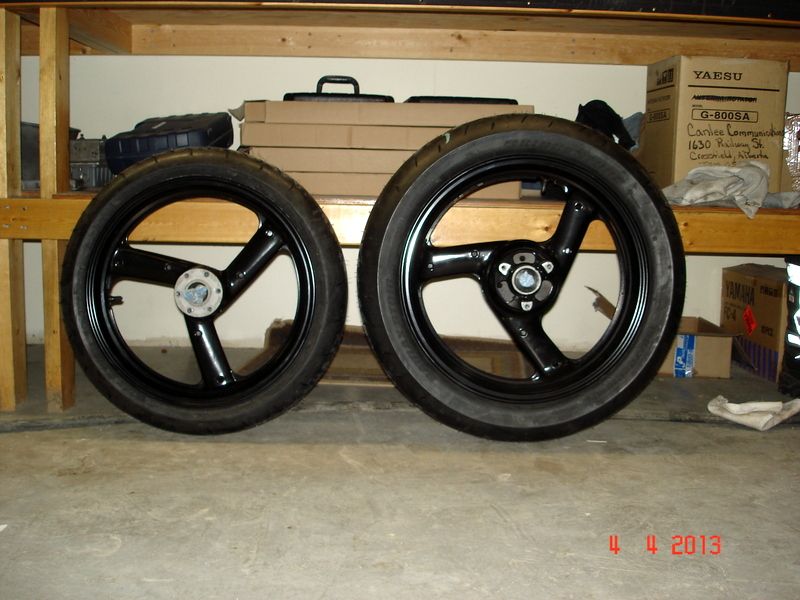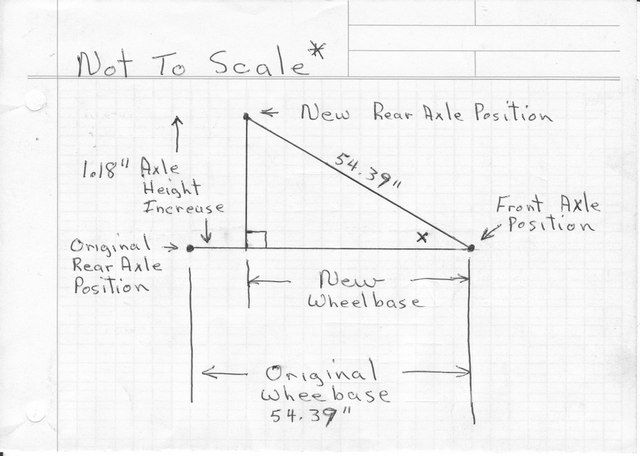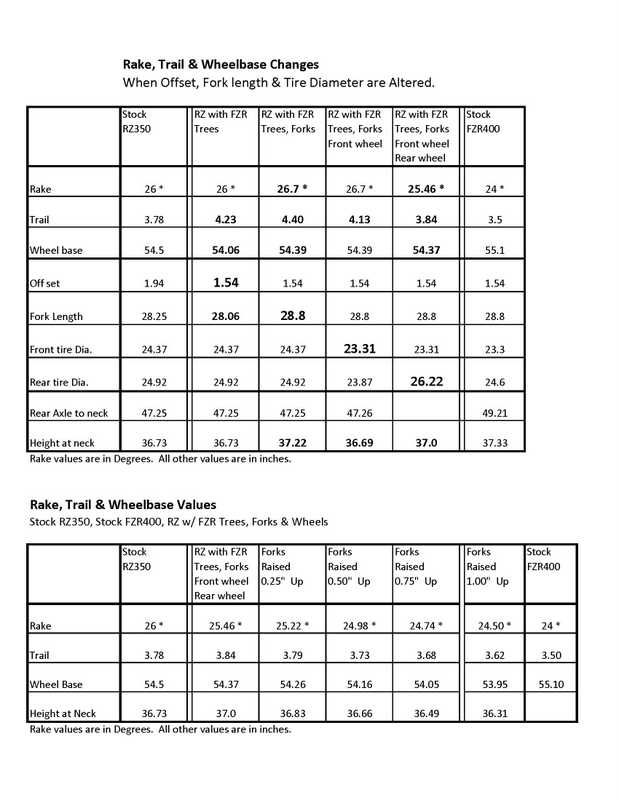If you want an hour of entertainment, read on, and on, and on. Sorry it's a long one.
Upgrading the suspension on my RZ sounds like it might have some benefits.
Maybe install a set of R1 forks, so that I have some compression & rebound damping.
Some wide 17" wheels with huge brake discs, so I can run some sticky tires, and be able to stop on a dime.
And it will look really cool.
And it's going to make some changes to the steering geometry, and handling characteristics, of the bike.
I've been on the net, and found a bit of info on the subject.
Here's a summary of the info that I thought was interesting / important.
Most of it is really obvious stuff, however, some of it did surprise me.
RAKE:
- When you are hard on the brakes and the front end dives, the rake decreases and the trail also decreases.
- A steeper rake decreases the amount of friction between the fork tubes and the sliders, which gives better resonse to small bumps.
- When the front fork compresses, the front wheel moves up, and back, in relation to the steering head.
A steeper rake angle, decreases the amount of backward movement, which decreases the 'change in trail', as the forks compress.
RZ350 rake is 26*. Yamaha R1 rake is 24*.
TRAIL:
The magical property, that keeps the front wheel self centered, and provides high speed stability.
But keeping the wheel pointing straight, isn't all that good, when you're trying to flick the bike through the S's, or power out of corner.
A steeper rake decreases trail.
A smaller front tire, decreases trail.
A smaller fork offset, increases trail.
RZ350 trail is 3.78". Yamaha R1 trail changed from 3.6", to 4.1", to 4.0", to 3.8".
WHEELBASE:
No magic here, Shorter bikes turn faster.
RZ350 wheelbase 54.5". R1 wheelbase changed from 54.9" to 55.7".
OFFSET:
Less fork offset results in more trail.
RZ350 offset is 1.94", 2002 R1 offset is 1.0". Some R1 models had 1.4" of offset.
SQUAT:
The force that sucks the rear end down, and extends the forks, when you're accelerating.
If I remember correctly, it's trying to rotate the top of the motor around the bike's center of gravity.
ANTI-SQUAT:
The force that pushes the rear of the bike up, when it's accelerating.
From what I understand, this dyno video is a really good example of anti-squat.
http://www.youtube.com/watch?v=9sSrQQ4Kx4M" onclick="window.open(this.href);return false;
Some of the things that affect anti-squat are the swing-arm angle, swing-arm length, and sprocket size.
SWING-ARM:
Under acceleration, the rear tire is applying a force to the swing-arm, which transfers it to the frame, at the swing-arm pivot.
Since the swing-arm is at an angle, the force is trying to push the bike forward and up, at the same time.
A steeper swing-arm angle increases anti-squat.
And a longer swing-arm decreases anti-squat.
Under acceleration, the top run of the chain, is tight between the front & rear sprockets,
The distance between the chain, and the swing-arm pivot, helps determine how much anti-squat you have.
Anti-squat increases when the chain gets closer to the pivot.
The swing-arm angle also plays an important part in how well the bike hooks up and accelerates, in a straight line, and when exiting corners.
SPROCKETS:
Just a smaller front sprocket, will bring the top of the chain, closer to the swing-arm pivot, and increase the anti-squat.
Just a larger rear sprocket, will change the angle between chain & swing-arm pivot, and increase anti-squat.
A combination of the two, screws things up, and requires complicated math to figure out.
REAR SHOCK:
A longer rear shock will increase the swing-arm angle, raise the rear ride height, steepen rake, and reduce trail.
It will also shorten the wheelbase, and increase the anti-squat, due to the steeper swing-arm angle.
The shock is connected to the frame through a linkage that pivots.
The linkage uses a lever so that large wheel travel results in a small shock travel.
Changes to the shock mount/pivot setup, could change the leverage, which may require changes to the spring rate,
which could lead to changes in the front springs, so that they match the rear.
(well, that's what someone said on one of the sites I read)
FRONT TIRE:
When the diameter of the front tire is reduced, the trail decreases.
REAR TIRE:
A larger rear tire will raise the rear ride height, steepen the rake, and reduce the trail.
It will also flatten the swing-arm angle, which will reduce the anti-squat.
Seems like a lot of things affect the anti-squat.
If you don't have enough anti-squat, then when you accelerate out of a corner,
the rear end will compress, rake will increase, the trail will increase, and the bike might want to drift wide.
In addition, a guy named John Robinson, wrote a book on motorcycle chassis tuning, said the following
"During acceleration, the full weight of the machine can be transferred to the rear wheel.
The suspension needs to be able to carry this load AND maintain a centre of gravity at a height which will give maximum traction.
If the centre of gravity is too low, the wheel will spin too easily; if it’s too high, the bike will overturn too easily"
So, if there's not enough anti-squat, it's a burnout.
And if there's too much anti-squat, it's an out of control wheelie.
Got it.
Now that I've read all this info, I'm ready to install the R1 front end, wheels, and swing-arm.
- Longer forks - will increase rake, increase trail, increase wheelbase, increase ride height and center of gravity
- Smaller offset - will increase trail, shorten wheelbase, increase ride height and center of gravity
- Smaller front tire - will decrease trail, ride height and center of gravity
- Longer swing-arm- increase wheelbase, reduce anti-squat
- Longer shock - increase swing-arm angle, increase anti-squat, raise rear ride height, shorten wheelbase, increase rake, decrease trail, raise the center of gravity
- Larger Rear tire - decrease anti-squat, increase rear ride height, increase rake, decrease trail, raise the center of gravity.
After I sort out and optimize the above items, I can adjust the compression & rebound damping.
And it's done!!!
I installed FZR400 suspension on my RZ.
After a bunch of measuring, and calculating, I determined that my new rake was 0.5* steeper, and trail was 1mm longer.
When riding the bike, I really don't notice this difference, because,
a - I'm not a very talented rider,
b - It's a Street bike, not a race bike.
What I do notice, is the awesome brakes, and incredible radial tires.
And it looks really cool.
Definitely worth the price of admission.
So, a couple of important things,
1 - I'm not trashing the idea of installing R1 suspension components on an RZ.
I'm just posting this to pass on information to people who might find it interesting or maybe even useful.
I have spent a number of hours with a rake & trail calculator, evaluating the RZ with both R1 components, and FZR400 suspension components.
And it's not that bad. With the R1 parts, the rake angle gets larger & trail gets quite a bit bigger, (mostly due to the small offset on the tree's).
However, by adjusting fork and shock length, you can make some changes to the rake, trail, wheelbase, and steering height.
And it's done!!!
2 - I've read a lot of things recently, and I'm still trying to understand most of it.
And, it's more than possible that I made some glaring errors in the above Summary.
So, don't trust anything that I said, If you're interested in the subject, look into it on your own.
The following links will give you much better information, than I did.
Basic info on rake,trail, wheelbase, and swing-arm angle.
http://sportbike.natkd.com/motorcycle_geometry_101.htm" onclick="window.open(this.href);return false;
Link on Squat, Anti-squat, Squat Adjustment, Sprocket size & Squat,
Sag, Fine tuning sag & ride height.
http://www.peterverdone.com/archive/rideheight.htm" onclick="window.open(this.href);return false;
Swing-arm angle, Chain Pull, and Anti-squat
http://www.sportrider.com/tech/146_0404 ... _geometry/" onclick="window.open(this.href);return false;
Sprocket size, and how it affects Anti-squat.
http://www.insidemotorcycles.com/featur ... squat.html" onclick="window.open(this.href);return false;
Link on shock linkages and Leverage.
Interesting section on matching front and rear spring rates
http://www.promecha.com.au/leverage_linkages.htm" onclick="window.open(this.href);return false;
Swing arm, Anti-squat, and using the rear brake.
http://www.msgroup.org/forums/mtt/topic ... PIC_ID=164" onclick="window.open(this.href);return false;
Excerpts from a book on Google. Good info on linkages, levers, and Anti-squat.
But it would be helpful to have a mech. engineering degree, to understand it all.
http://books.google.ca/books?id=l2Zizg8 ... le&f=false" onclick="window.open(this.href);return false;
Yamaha R1 engineering info.
Interesting info on page 2 about the swing-arm angle and fork offset.
http://www.yamaha-motor.eu/designcafe/e ... lse&page=2" onclick="window.open(this.href);return false;
Yamaha R1 info on Wikipedia.
http://en.wikipedia.org/wiki/Yamaha_YZF-R1" onclick="window.open(this.href);return false;







